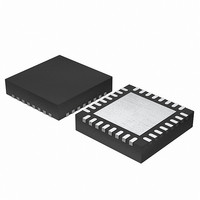EFM32G200F16 Energy Micro, EFM32G200F16 Datasheet - Page 160

EFM32G200F16
Manufacturer Part Number
EFM32G200F16
Description
MCU 32BIT 16KB FLASH 32-QFN
Manufacturer
Energy Micro
Series
Geckor
Datasheets
1.EFM32G200F16.pdf
(63 pages)
2.EFM32G200F16.pdf
(10 pages)
3.EFM32G200F16.pdf
(463 pages)
4.EFM32G200F16.pdf
(136 pages)
Specifications of EFM32G200F16
Core Processor
ARM® Cortex-M3™
Core Size
32-Bit
Speed
32MHz
Connectivity
EBI/EMI, I²C, IrDA, SmartCard, SPI, UART/USART
Peripherals
Brown-out Detect/Reset, DMA, POR, PWM, WDT
Number Of I /o
24
Program Memory Size
16KB (16K x 8)
Program Memory Type
FLASH
Ram Size
8K x 8
Voltage - Supply (vcc/vdd)
1.8 V ~ 3.8 V
Data Converters
A/D 4x12b, D/A 1x12b
Oscillator Type
External
Operating Temperature
-40°C ~ 85°C
Package / Case
32-VQFN Exposed Pad
Processor Series
EFM32G200
Core
ARM Cortex-M3
Data Bus Width
32 bit
Data Ram Size
8 KB
Interface Type
I2C, UART
Maximum Clock Frequency
32 MHz
Number Of Programmable I/os
24
Number Of Timers
2
Operating Supply Voltage
1.8 V to 3.8 V
Maximum Operating Temperature
+ 85 C
Mounting Style
SMD/SMT
Minimum Operating Temperature
- 40 C
Lead Free Status / RoHS Status
Lead free / RoHS Compliant
Eeprom Size
-
Lead Free Status / Rohs Status
Details
- EFM32G200F16 PDF datasheet
- EFM32G200F16 PDF datasheet #2
- EFM32G200F16 PDF datasheet #3
- EFM32G200F16 PDF datasheet #4
- Current page: 160 of 463
- Download datasheet (8Mb)
15.3.11 Using 10-bit Addresses
15.3.12 Error Handling
15.3.12.1 ABORT command
15.3.12.2 Bus Reset
15.3.12.3 I
15.3.12.4 Bus Lockup
2010-09-06 - d0001_Rev1.00
When using 10-bit addresses in slave mode, set the I2Cn_SADDR register to 1111 0XX where XX
are the two most significant bits of the 10-bit address, and set I2Cn_SADDRMASK to 0xFF. Address
matches will now be given on all 10-bit addresses where the two most significant bits are correct.
When receiving an address match, the slave must acknowledge the address and receive the first data
byte. This byte contains the second part of the 10-bit address. If it matches the address of the slave,
the slave should ACK the byte to continue the transmission, and if it does not match, the slave should
NACK it.
When the master is operating as a master transmitter, the data bytes will follow after the second address
byte. When the master is operating as a master receiver however, a repeated START condition is sent
after the second address byte. The address sent after this repeated START is equal to the first of the
address bytes transmitted previously, but now with the R/W byte set, and only the slave that found a
match on the entire 10-bit address in the previous message should ACK this address. The repeated
start should take the master into a master receiver mode, and after the single address byte sent this
time around, the slave begins transmission to the master.
Some bus errors may require software intervention to be resolved. The I
command, which can be set in I2Cn_CMD, to help resolve bus errors.
When the bus for some reason is locked up and the I
cannot get out of, or for some other reason the I
can be used.
Setting the ABORT command will make the I
or received, release the SDA and SCL lines and go to an idle mode. ABORT effectively makes the I
module forget about any ongoing transfers.
A bus reset can be performed by setting the START and STOP commands in I2Cn_CMD while the
transmit buffer is empty. A START condition will then be transmitted, immediately followed by a STOP
condition. A bus reset can also be performed by transmitting a START command with the transmit buffer
empty and AUTOSE set.
An I
on SDA changes while SCL is high during bit-transmission on the I
the current transmission when a bus error occurs, any data currently being transmitted or received is
discarded, SDA and SCL are released, the BUSERR interrupt flag in I2Cn_IF is set to indicate the error,
and the module automatically takes a course of action as defined in Table 15.10 (p. 160) .
Table 15.10. I
A lockup occurs when a master or slave on the I
preventing other devices from putting high values on the bus, and thus making communication on the
bus impossible.
2
C-bus error occurs when a START or STOP condition is misplaced, which happens when the value
In a master/slave operation
2
C-Bus Errors
2
C Bus Error Response
Misplaced START
Treated as START. Receive address.
2
C module discard any data currently being transmitted
2
...the world's most energy friendly microcontrollers
C wants to abort a transmission, the ABORT command
160
2
C-bus has locked the SDA or SCL at a low value,
2
C module is in the middle of a transmission it
2
C-bus. If the I
Misplaced STOP
Go idle. Perform any pending actions.
2
C module provides an ABORT
www.energymicro.com
2
C module is part of
2
C
Related parts for EFM32G200F16
Image
Part Number
Description
Manufacturer
Datasheet
Request
R

Part Number:
Description:
KIT STARTER EFM32 GECKO
Manufacturer:
Energy Micro
Datasheet:

Part Number:
Description:
KIT DEV EFM32 GECKO LCD SUPPORT
Manufacturer:
Energy Micro
Datasheet:

Part Number:
Description:
BOARD PROTOTYPING FOR EFM32
Manufacturer:
Energy Micro
Datasheet:

Part Number:
Description:
KIT DEVELOPMENT EFM32 GECKO
Manufacturer:
Energy Micro
Datasheet:

Part Number:
Description:
MCU, MPU & DSP Development Tools TG840 Sample Kit
Manufacturer:
Energy Micro
Datasheet:

Part Number:
Description:
MCU, MPU & DSP Development Tools TG Starter Kit
Manufacturer:
Energy Micro
Datasheet:

Part Number:
Description:
MCU, MPU & DSP Development Tools TG108 Sample Kit
Manufacturer:
Energy Micro

Part Number:
Description:
MCU, MPU & DSP Development Tools TG210 Sample Kit
Manufacturer:
Energy Micro
Datasheet:

Part Number:
Description:
MCU, MPU & DSP Development Tools TG822 Sample Kit
Manufacturer:
Energy Micro
Datasheet:

Part Number:
Description:
MCU, MPU & DSP Development Tools TG230 Sample Kit
Manufacturer:
Energy Micro

Part Number:
Description:
SAMPLE KIT (SMALL BOX - CONTAINING 2 DEVICES)
Manufacturer:
Energy Micro

Part Number:
Description:
SAMPLE KIT (SMALL BOX - CONTAINING 2 DEVICES)
Manufacturer:
Energy Micro










